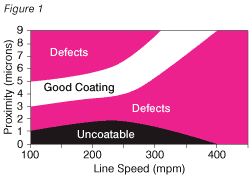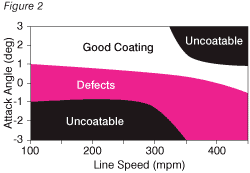Coating Matters: Open Up the Coating Process Window
- Published: May 01, 2011, By By Mark Miller Contributing Editor
If you have worked around a coating process facility, you have undoubtedly heard someone refer to the coating process window. This statistical assessment of the capabilities of the equipment as it interacts with the materials is the key to optimizing the money you can make.
Whoa! Did I get your attention? Yes, the money you make with the equipment and materials at your disposal is based on the yield of the final converted product you are selling in roll form. More yield equals more money. To maximize yield, you need to know where the coated product is good and where it fails.

Pushing the process to its limits and mapping the extent of these variables on a graph will provide you with an understanding of a process in which the coating can survive. This map of the process is the coating window (see Figure 1 and Figure 2).
To develop the coating window, you need to understand the critical processes that control your system. In slot die coating, the variables that can pry open the window (or slam it shut) are the slot die attack angle, the slot die-to-substrate proximity, the slot die lip (offset/geometry/gap), along with the line speed, raw material variation, and equipment precision. Because you typically are stuck with the raw materials developed for the product and the line speed requirements for the market pricing, the variables to be considered in the coating process window are centered at the coating station.

Making sure the backing roll, the positioning stand, and the coating head are manufactured to exacting tolerances is the first step to opening the window of coatability. After this equipment precision is verified, it is time to get to work.
The slot die can be varied physically at high and low line speeds to determine if the final coated product is acceptable. In the example presented in Figure 1, a good coating (one that is acceptable to the end-user) can be achieved up to 400 mpm. However, as the speed is increased, the coating head needs to be moved farther away from the substrate. This picture of coating quality gives the operator a good idea of where to go based on empirical data.
In the example presented in Figure 2, a good coating falls within 1-3 deg of the attack angle of the die to the substrate. The attack angle is the radial variation from tangent that the slot die lips are from the centerline of the backing roll.
You will notice, however, that above 350 mpm, the coating seems to fall off a cliff. This would warn the coating operators that as speed increases, they would be well positioned if they adjusted the coating head closer to 1 deg.
To achieve the coating process windows presented here, a design of experiments (DOE) should be conducted to develop the limits of the operating system. The key to success, however, is to push the process beyond the acceptable limits.
A good rule of thumb is to go 20% more than the limit tested. For example, if the plan is to run the coating line at 300 mpm, it needs to be tested at least to 360 mpm.
Now, if the coating is still good at 360 mpm, don't stop! Push the system so the next time you are asked to make a process improvement, the DOE does not have to be redone. This preliminary experimental work will turn the current process window into a chasm of opportunity. Open it up, and let the profits come in!
Roll-to-roll coating industry expert Mark Miller, owner of Coating Tech Service, has 14+ years of slot die coating experience and troubleshooting. Contact him at 612-605-6019; mark@coatingtechservice.com; www.coatingtechservice.com.







